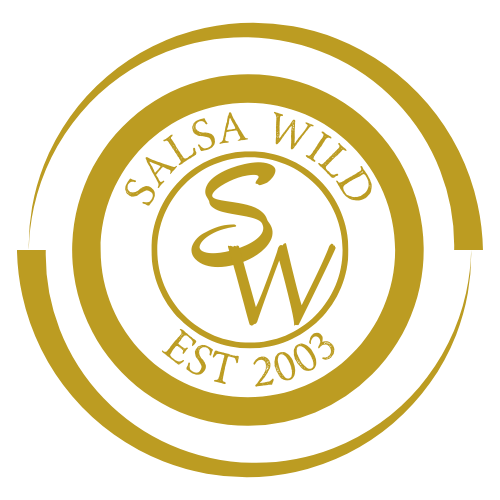Salsa Dance
Read More
Salsa is a partnered dance where the lead leads the follow through a series of spins and turn patterns to music. Salsa dancers can also break apart during a dance to dance solo, known as “shines”.
There are two main styles of salsa: linear and circular.
In linear salsa, dancers remain in their “slot”, switching places from one side of the slot to the other, similar to West Coast Swing. New York style salsa and LA style salsa are both danced in this fashion.
The second style of salsa is circular salsa, where the dancers circle around each other, reminiscent of East Coast Swing. Both Cuban style salsa and Colombian salsa follow this circular pattern.
Incorporating other dance styling techniques into salsa dancing has become very common for both men and women: shimmies, leg work, arm work, body movement, spins, body isolations, shoulder shimmies, rolls, even hand styling, acrobatics and lifts.
Salsa generally uses music suitable for dancing ranges from about 150 bpm (beats per minute) to around 250 bpm, although most dancing is done to music somewhere between 160 and 220 bpm.
The key instrument that provides the core groove of a salsa song is the clave. It is often played with two wooden sticks (called clave) that are hit together. Every instrument in a salsa band is either playing with the clave (generally: congas, timbales, piano, tres guitar, bongos, claves (instrument), strings) or playing independent of the clave rhythm (generally: bass, maracas, güiro, cowbell). Melodic components of the music and dancers can choose to be in clave or out of clave at any point.
Over the years many different styles of salsa dancing have evolved around the world. Many of them are compatible with each other, but others are different enough to make dancing between dancers of different styles difficult.
Incorporating other dance styling techniques into salsa dancing has also become common, with dancers of one style incorporating styles and movements of others to create new fusions of dance styles.
New York Style New York City is where salsa music originated and the style of salsa dancing that originated in the city bears its name.
New York style salsa is a linear form of salsa, where dancers dance in a slot, similar to LA style salsa. Unlike other styles of salsa, however, New York style is danced on the second beat of the music (“on 2”), and the follower, not the leader, steps forward on the first measure of the music. There is also often a greater emphasis on performing “shines” in which dancers separate themselves and dance solo with intricate footwork and styling— a phenomenon that likely has origins from Swing and New York Tap.
Los Angeles style salsa (LA style) is danced “on 1” where dancers break forward on the first beat of the music, in contrast to New York style which is danced on 2. LA style salsa is danced in a line or “slot” with dancers exchanging positions throughout the dance, unlike Cuban salsa which is danced in a more circular fashion.
Rueda De Casino In the 1950s Salsa Rueda or more accurately Rueda de Casino was developed in Havana, Cuba. Pairs of dancers form a circle (“Rueda” in Spanish means “Wheel”), with dance moves called out by one person. Many of the moves involve rapidly swapping partners.
“Rueda de Cuba” is original type of Rueda, originating from Cuba. It is not as formal as Rueda de Miami and consists of about 30 calls. It was codified in the 1970s.
“Rueda de Miami” originated in the 1980s from Miami, is a formal style with many rules based on a mix, and is a hybridization of Rueda de Cuba & North American dance styles, with some routines reflecting American culture (e.g. Coca-Cola, Dedo, Adios) which is not found in the traditional Cuban-style Rueda.



